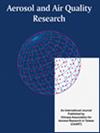口罩与预防呼吸道病毒感染:综述
IF 2.5
4区 环境科学与生态学
Q3 ENVIRONMENTAL SCIENCES
引用次数: 1
摘要
呼吸道病毒的空气传播包括三个连续的步骤:(1)以飞沫形式从感染者的口鼻释放呼吸道液体,(2)飞沫通过空气传播,以及(3)飞沫进入未感染者的口鼻。说话、咳嗽和打喷嚏都会释放出大小不一的飞沫。被呼出的水滴中的水开始在空气中蒸发,因此,水滴在被释放后不久就变小了。口罩可以有效地捕捉刚从鼻子和嘴里释放出来的飞沫。研究表明,50%以上的SARS-CoV-2社区传播来自无症状和症状前病例。市民佩戴口罩可有效减少感染者在不知情的情况下传播病毒的机会。口罩除了是一种有效的源头控制设备外,还可以保护佩戴者不吸入含有病毒的飞沫。布口罩和一次性口罩为公众提供合理的保护,而外科口罩和N95呼吸器则根据医疗机构的需要提供更高水平的保护。这些口罩由不同的材料制成,具有不同的结构特征。口罩的收集效率取决于液滴大小、面速度和口罩的结构特性。对于给定的口罩,在呼气时捕获液滴比在吸气时更有效。选择口罩时应考虑面罩上的压降。最好的口罩是能以最小的压降提供最高的收集效率。为了有效的保护,口罩应该适合面部。虽然口罩已被证明足以减少SARS-CoV-2感染的空气传播,但需要不断改进,以更好地为未来的呼吸道病毒威胁做好准备。©作者。这是一篇在知识共享署名许可(CC BY 4.0)条款下发布的开放获取文章,该许可允许在任何媒体上不受限制地使用、分发和复制,只要注明原作者和来源。本文章由计算机程序翻译,如有差异,请以英文原文为准。
Face Masks and Prevention of Respiratory Viral Infections: An Overview
Airborne transmission of respiratory viruses consists of three sequential steps: (1) release of respiratory fluids in the form of droplets from the nose and mouth of an infected person, (2) transport of the droplets through air, and (3) entry of the droplets into the nose and mouth of an uninfected individual. Talking, coughing, and sneezing emit droplets across a spectrum of sizes. The water in exhaled droplets begins to evaporate in air and, as a result, the droplets are reduced in size shortly after being emitted. Face masks are effective for capturing droplets just released from the nose and mouth. Studies indicate that more than 50% of community transmission of SARS-CoV-2 is from asymptomatic and pre-symptomatic cases. Use of face masks by the public can effectively reduce the chance of infected individuals unknowingly spreading the virus. In addition to being an effective device for source control, face masks can protect the wearers from inhaling virus-laden droplets. Cloth masks and disposable masks provide reasonable protection for the public, while surgical masks and N95 respirators give higher levels of protection as needed in healthcare settings. Made with varied materials, these masks have different structural characteristics. The collection efficiency of a face mask depends on droplet size, face velocity, and the structural characteristics of the mask. For a given mask, capturing droplets is more effective during exhalation than during inhalation. Pressure drop across the mask should be taken into consideration when selecting a face mask. The best face mask is the one that gives the highest collection efficiency with the least pressure drop. For an effective protection, a mask should fit the face properly. While face masks have proven adequate in reducing airborne transmission of SARS-CoV-2 infections, continuous improvement is needed to better prepare for future respiratory viral threats. © The Author(s). This is an open access article distributed under the terms of the Creative Commons Attribution License (CC BY 4.0), which permits unrestricted use, distribution, and reproduction in any medium, provided the original author and source are cited.
求助全文
通过发布文献求助,成功后即可免费获取论文全文。
去求助
来源期刊

Aerosol and Air Quality Research
ENVIRONMENTAL SCIENCES-
CiteScore
8.30
自引率
10.00%
发文量
163
审稿时长
3 months
期刊介绍:
The international journal of Aerosol and Air Quality Research (AAQR) covers all aspects of aerosol science and technology, atmospheric science and air quality related issues. It encompasses a multi-disciplinary field, including:
- Aerosol, air quality, atmospheric chemistry and global change;
- Air toxics (hazardous air pollutants (HAPs), persistent organic pollutants (POPs)) - Sources, control, transport and fate, human exposure;
- Nanoparticle and nanotechnology;
- Sources, combustion, thermal decomposition, emission, properties, behavior, formation, transport, deposition, measurement and analysis;
- Effects on the environments;
- Air quality and human health;
- Bioaerosols;
- Indoor air quality;
- Energy and air pollution;
- Pollution control technologies;
- Invention and improvement of sampling instruments and technologies;
- Optical/radiative properties and remote sensing;
- Carbon dioxide emission, capture, storage and utilization; novel methods for the reduction of carbon dioxide emission;
- Other topics related to aerosol and air quality.
 求助内容:
求助内容: 应助结果提醒方式:
应助结果提醒方式:


